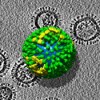 A plea from a Sciencebase reader asking for more information on new treatments for COPD, chronic obstructive pulmonary disease, led me to do a search to find the specific novel therapy the reader mentioned. Apparently, there was a news item on US TV that referred to research in Mexico.
A plea from a Sciencebase reader asking for more information on new treatments for COPD, chronic obstructive pulmonary disease, led me to do a search to find the specific novel therapy the reader mentioned. Apparently, there was a news item on US TV that referred to research in Mexico.
Well, my search turned up several new treatments for COPD. Medical News Today reported in January how combining a long-acting bronchodilator with an inhaled corticosteroid could reduce the number of exacerbations by 35%, but this was work carried out Germany, with no Mexican connection as far as I could tell. Then there were the more recent revelation that helium, the noble gas of squeaky voice fame, combined with 40% oxygen could increase the exercise capacity of patients with COPD by an average of 245%. Again, no Mexican connection, this time the research was Canadian.
A UK and Canadian collaboration has identified an inflammatory mechanism that could explain some of the most extreme symptoms and point to new treatments. Indeed, Imperial College’s Peter Barnes had shown previously that low doses of theophylline, a substance occurring in tea leaves can help relax the bronchial tubes in the lungs and render them more amenable to corticosteroid intervention than they would otherwise be.
It might be that one in ten of COPD flare-ups could be prevented by treating patients with antibiotics to rid them of the bacterium thought to cause these problems in a sub-group of patients.
COPD is the fourth leading cause of death in the US and in January this year the National Institutes of Health put up $13 million to the University of Pittsburgh to help researchers there understand better the disease and potentially find more effective treatments. COPD, some times known as chronic obstructive airways disease (COAD) is most commonly associated with smoking tobacco (you’ve got a hugely increased risk of this disease if you have smoked an average of 20 cigarettes a day for 20 years or more across your lifetime) but the disease can also arise because of coal dust and other pollutants. I say disease, but it’s actually a combination of diseases chronic bronchitis (which is inflammatory, in nature, narrows airways and increases mucus production) and emphysema (destruction of lung tissue).
Still no Mexico connection, not even with a search on NCBI PubMed… Then I received another email from the Sciencebase correspondent who revised the original note to include the word “new” it was New Mexico…not old Mexico. I should have thought of that first off, but I didn’t. However, a quick search with new included brought up the item that I suspect our correspondent had heard about.
Apparently, the Lovelace Respiratory Research Institute is collaborating with Dr Richard Crowell of the Albuquerque Veterans Administration Medical Center to begin a new study over the next three years that will enlist more than 3000 Albuquerque area residents at risk of COPD and lung cancer. Now, this isn’t quite the treatment breakthrough mentioned in the original email, but this looks like another promising lead in dealing with COPD.
 Solid state NMR is unlocking the secrets of compounds found in natural membranes from frogs’ legs to human lungs that could lead to an entirely new class of antibiotic drugs. The compounds in question are antimicrobial peptides (AMPs) and they have been detected in every living creature studied so far. AMPs act as a first line chemical defence system in a huge range of organisms and could provide a novel approach to defeating drugs resistance in bacteria.
Solid state NMR is unlocking the secrets of compounds found in natural membranes from frogs’ legs to human lungs that could lead to an entirely new class of antibiotic drugs. The compounds in question are antimicrobial peptides (AMPs) and they have been detected in every living creature studied so far. AMPs act as a first line chemical defence system in a huge range of organisms and could provide a novel approach to defeating drugs resistance in bacteria. Both the UK and US national diabetes organizations have a risk test available for anyone worried about diabetes risk. Read the rest of this post and then take the tests and let me know how you get on.
Both the UK and US national diabetes organizations have a risk test available for anyone worried about diabetes risk. Read the rest of this post and then take the tests and let me know how you get on. Just £300,000 (about $600k) is being plugged into a national public debate by the UK government on stem cell research. According to Science and Innovation Minister Malcolm Wicks the UK’s two major public funders of stem cell research will use the cash to run a national public discussion about this cutting-edge area of science.
Just £300,000 (about $600k) is being plugged into a national public debate by the UK government on stem cell research. According to Science and Innovation Minister Malcolm Wicks the UK’s two major public funders of stem cell research will use the cash to run a national public discussion about this cutting-edge area of science. Could the contraceptive pill be replaced by a “natural” approach to family planning? It could if a study by Petra Frank-Herrmann of the Department of Gynaecological Endocrinology at the University of Heidelberg, Germany, proves reproducible (pardon the pun).
Could the contraceptive pill be replaced by a “natural” approach to family planning? It could if a study by Petra Frank-Herrmann of the Department of Gynaecological Endocrinology at the University of Heidelberg, Germany, proves reproducible (pardon the pun). “The US Food & Drug Administration’s (FDA) position on medical cannabis is incorrect, dishonest and a flagrant violation of laws requiring the government to base policy on sound science,” claims Joe Elford, Chief Counsel for patient advocacy group. The organisation, the largest of its type in the US promoting safe and legal access to cannabis for therapeutic use and research, has filed a lawsuit demanding that the federal government “cease issuing misinformation on medical cannabis and correct the information it has released.”
“The US Food & Drug Administration’s (FDA) position on medical cannabis is incorrect, dishonest and a flagrant violation of laws requiring the government to base policy on sound science,” claims Joe Elford, Chief Counsel for patient advocacy group. The organisation, the largest of its type in the US promoting safe and legal access to cannabis for therapeutic use and research, has filed a lawsuit demanding that the federal government “cease issuing misinformation on medical cannabis and correct the information it has released.” Bees making honey from honeydew rather than nectar produce a sweet material that has greater anti oxidant properties than nectar honey, according to a study of 36 honey samples from Spain with different floral origins. The study published this month in the Journal of the Science of Food and Agriculture could point to a way to improve the health benefits of this natural sweetener.
Bees making honey from honeydew rather than nectar produce a sweet material that has greater anti oxidant properties than nectar honey, according to a study of 36 honey samples from Spain with different floral origins. The study published this month in the Journal of the Science of Food and Agriculture could point to a way to improve the health benefits of this natural sweetener. If the avian influenza virus, H5N1, ever gets around to mutating into a lethal and virulent form that can be passed on readily from one person to another, then we will be facing a pandemic. Of course, as some observers have pointed out, mainly those without a vested interest in scaremongering, the process of mutation would more than likely lead to a strain of the disease that was not so commonly lethal in people, just as it is not commonly lethal in the natural wild bird hosts.
If the avian influenza virus, H5N1, ever gets around to mutating into a lethal and virulent form that can be passed on readily from one person to another, then we will be facing a pandemic. Of course, as some observers have pointed out, mainly those without a vested interest in scaremongering, the process of mutation would more than likely lead to a strain of the disease that was not so commonly lethal in people, just as it is not commonly lethal in the natural wild bird hosts. According to an article in the New York Times magazine recently, there are nine golden rules of nutrition that in these days of overweight obesics, rising sugar levels, and general all-round fitness collapse, we could all do well to follow. Or, could we?
According to an article in the New York Times magazine recently, there are nine golden rules of nutrition that in these days of overweight obesics, rising sugar levels, and general all-round fitness collapse, we could all do well to follow. Or, could we? A plea from a Sciencebase reader asking for more information on new treatments for COPD, chronic obstructive pulmonary disease, led me to do a search to find the specific novel therapy the reader mentioned. Apparently, there was a news item on US TV that referred to research in Mexico.
A plea from a Sciencebase reader asking for more information on new treatments for COPD, chronic obstructive pulmonary disease, led me to do a search to find the specific novel therapy the reader mentioned. Apparently, there was a news item on US TV that referred to research in Mexico.